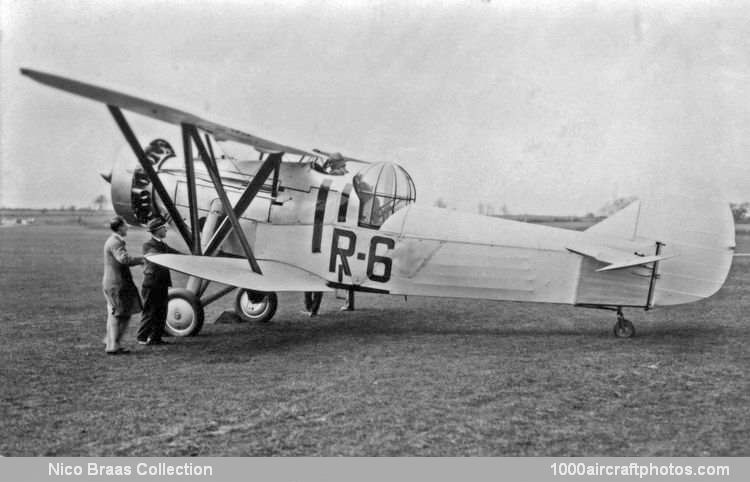10/31/2018. Remarks by Johan Visschedijk: "During the 1920s and 1930s there existed a type of aeroplane that was not found before and has not been since, the General Purpose aircraft. Best epitomized by the Airco D.H.9A and the Westland Wapiti, the general purpose aircraft was designed to fulfil a multitude of roles where financial stringency dictated that many different types of aircraft each operating to a singular purpose could not be afforded.
During the summer of 1929, Frank S. Barnwell, the Chief Designer of the Bristol Aeroplane Company Limited at Filton, Bristol, proposed the Bristol Type 118, a general purpose biplane. It was hoped that this aeroplane would emulate the success of the Bristol Fighter in the general purpose role, also appeal to smaller air forces and thus follow Bristol's Bulldog into the export market.
The Type 118 was a two-seat aeroplane of conventional construction. The fuselage was built of steel tubing joined by high tensile steel plates whilst the wing spars were of high tensile steel strips with ribs of drawn steel channeling. The front and extreme rear of the fuselage were covered with detachable metal panels, whilst the rest of the airframe was covered in fabric. The power plant was the 590 hp Bristol Jupiter XFA nine-cylinder air-cooled radial, and the armament was a 0.303 in (7.7 mm) Vickers gun for the pilot and a 0.303 in (7.7 mm) Lewis gun on a scarff ring for the observer. The bomb load consisted of either two 250 lb (113 kg), four 112 lb (51 kg) or sixteen 20 lb (9 kg) bombs.
Two Type 118s were produced by Bristol as a private venture, and the first of these registered G-ABEZ (c/n 7561, piloted by Chief Test Pilot Cyril F. Uwins), flew for the first time on January 22, 1931. The performance of the Type 118 was excellent, Uwins finding the aeroplane easy to fly and land, stable at all speeds and capable of being dived to a speed of 210 mph (334 kmh). Because of the high seating positions the field of view for both pilot and observer was excellent.
Late in 1931 the Type 118 went to Martlesham Heath for airworthiness trials, where its performance was confirmed as most satisfactory. Subsequently it was intended that the Type 118 would go on a sales tour of Scandinavia, Estonia, Lithuania and Latvia. At this time however Bristols had an arrangement with the French Gnome & Rhône Company, that British manufactured engines would not be fitted to Bristol aircraft exported to certain countries. As a result the Bristol Jupiter or Mercury could not be fitted to exports to the Baltic States and at that time Bristols were not satisfied that the Gnome & Rhône license produced Mercury was yet ready for sale. As a result the proposed sales tour to the Baltic States and Scandinavia was abandoned.
Early in 1932 the Type 118 was modified to accept the Bristol Mercury V engine and after allocation of the RAF serial K2873 the aeroplane undertook hot weather trials in Iraq. The RAF was very impressed with the Type 118 and as a result the second example was rebuilt as the Type 120, and submitted as a contender to specification G4/31. This specification was intended to find a replacement for the Westland Wapiti and the Fairey Gordon.
The Type 120 differed primarily from the Type 118 in being fitted with a cupola for the observer which afforded him substantial protection from the slipstream. This rotating cupola consisted of transparent panels in a metal frame, and was effectively an early form of power operated turret. The benefits to the observer were substantial. Allocated the 'Class B' marking R-6, the Type 120 was flying for the first time on January 29, 1932.
Originally powered by a Bristol Mercury V, this was replaced in April by a Bristol Pegasus IM3. Although the flying characteristics of the Type 120 were also excellent it was not the successful contender to specification G4/31. The prime reason for this was that in October 1931 the specification had been further widened to encompass coastal reconnaissance and torpedo bombing, roles to which the design of the Type 120 was not suited. The Type 120 was however allocated RAF serial K3587 and trials continued throughout 1932 at Martlesham Heath. At this time the Spanish Government also evinced some interest in procuring the Type 120 but once again engine licensing problems precluded the possibility of a sale and the Spanish interest came to nothing.
The Type 118 ended its days as a test bed for the Pegasus PE-5SM prototype engine with two-speed supercharger, of which the production version, the Pegasus XVIII, was later used in the Handley Page Hampden and the Vickers Wellington. Although the Types 118 and 120 were not put into production they were nevertheless very successful aeroplanes and but for the engine licensing problems, might well have seen service with some of the smaller air forces for which they were originally designed."
